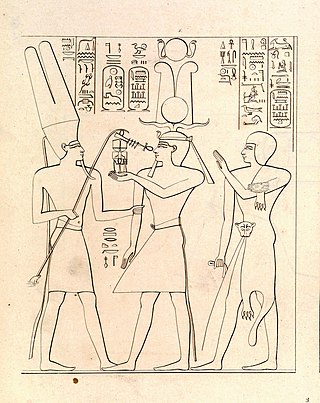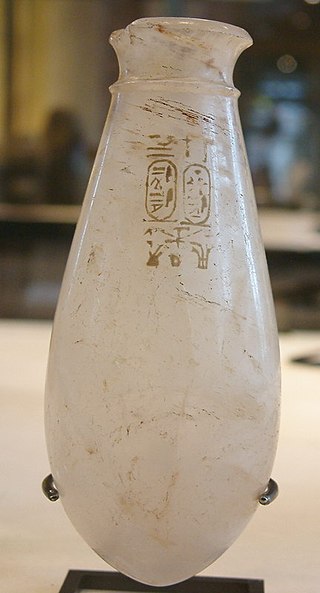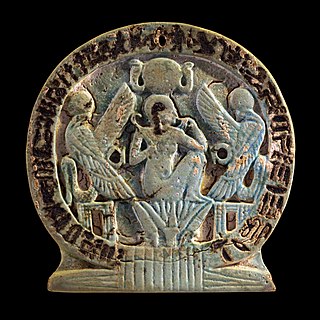Related Research Articles

Hedjkheperre Setepenre Shoshenq I —also known as Shashank or Sheshonk or Sheshonq I—was a pharaoh of ancient Egypt and the founder of the Twenty-second Dynasty of Egypt. Of Meshwesh ancestry, Shoshenq I was the son of Nimlot A, Great Chief of the Ma, and his wife Tentshepeh A, a daughter of a Great Chief of the Ma herself; Shoshenq was thus the nephew of Osorkon the Elder, a Meshwesh king of the 21st Dynasty. He is generally presumed to be the Shishak mentioned in the Hebrew Bible, and his exploits are carved on the Bubastite Portal at Karnak.

Titkheperure or Tyetkheperre Psusennes II [Greek Ψουσέννης] or Hor-Pasebakhaenniut II [Egyptian ḥr-p3-sb3-ḫˁỉ-⟨n⟩-nỉwt], was the last king of the Twenty-first Dynasty of Egypt. His royal name means "Image of the transformations of Re" in Egyptian. Psusennes II is often considered the same person as the High-Priest of Amun known as Psusennes III. The Egyptologist Karl Jansen-Winkeln notes that an important graffito from the Temple of Abydos contains the complete titles of a king Tyetkheperre Setepenre Pasebakhaenniut Meryamun "who is simultaneously called the HPA and supreme military commander." This suggests that Psusennes was both king at Tanis and the High Priest in Thebes at the same time, meaning he did not resign his office as High Priest of Amun during his reign. The few contemporary attestations from his reign include the aforementioned graffito in Seti I's Abydos temple, an ostracon from Umm el-Qa'ab, an affiliation at Karnak and his presumed burial – which consists of a gilded coffin with a royal uraeus and a Mummy, found in an antechamber of Psusennes I's tomb at Tanis. He was a High Priest of Amun at Thebes and the son of Pinedjem II and Istemkheb. His daughter Maatkare B was the Great Royal Wife of Osorkon I.

Hedjkheperre Setepenre Takelot II Si-Ese was a pharaoh of the Twenty-third Dynasty of Ancient Egypt in Middle and Upper Egypt. He has been identified as the High Priest of Amun Takelot F, son of the High Priest of Amun Nimlot C at Thebes, and thus, the son of Nimlot C and grandson of king Osorkon II, according to the latest academic research. Based on two lunar dates belonging to Takelot II, this Upper Egyptian pharaoh is today believed to have ascended to the throne of a divided Egypt in either 845 BC or 834 BC. Most Egyptologists today, including Aidan Dodson, Gerard Broekman, Jürgen von Beckerath, M.A. Leahy, and Karl Jansen-Winkeln, also accept David Aston's hypothesis that Shoshenq III was Osorkon II's actual successor at Tanis, rather than Takelot II. As Aidan Dodson and Dyan Hilton write in their comprehensive book on the royal families of Ancient Egypt:
Takelot II is likely to have been identical with the High Priest Takelot F, who is stated in [the] Karnak inscriptions to have been a son of Nimlot C, and whose likely period of office falls neatly just before Takelot II's appearance.

Usermaatre Setepenamun Osorkon II was the fifth king of the Twenty-second Dynasty of Ancient Egypt and the son of King Takelot I and Queen Kapes. He ruled Egypt from approximately 872 BC to 837 BC from Tanis, the capital of that dynasty.

Sekhemkheperre Osorkon I was an ancient Egyptian pharaoh of the 22nd Dynasty. Osorkon's territory included much of the Levant.
Osorkon was the name of many ancient Egyptians with Libyan ancestry. It could refers to:

The Twenty-second Dynasty of Egypt is also known as the Bubastite Dynasty, since the pharaohs originally ruled from the city of Bubastis. It was founded by Shoshenq I.

The Twenty-third Dynasty of Egypt is usually classified as the third dynasty of the ancient Egyptian Third Intermediate Period. This dynasty consisted of a number of Meshwesh kings, who ruled either as pharaohs or as independent kings of parts of Upper Egypt from 880 BC to 720 BC, and pharaohs from 837 BC to 728 BC.
The Meshwesh was an ancient Libyan Berber tribe, along with other groups like Libu and Tehenou/Tehenu.

Heqakheperre Shoshenq II or Shoshenq IIa was a pharaoh of the Twenty-second Dynasty of Egypt. He was the only ruler of this dynasty whose tomb was not plundered by tomb robbers. His final resting place was discovered within an antechamber of Psusennes I's tomb at Tanis by Pierre Montet in 1939. Montet removed the coffin lid of Shoshenq II on March 20, 1939, in the presence of king Farouk of Egypt himself. It proved to contain many jewel-encrusted bracelets and pectorals, along with a beautiful hawkheaded silver coffin and a gold funerary mask. The facemask had been placed upon the head of the king. Montet later discovered the intact tombs of two Twenty-first Dynasty kings a year later in February and April 1940 respectively. Shoshenq II's prenomen, Heqakheperre Setepenre, means "The manifestation of Ra rules, the chosen one of Ra."

Jürgen von Beckerath was a German Egyptologist. He was a prolific writer who published countless articles in journals such as Orientalia, Göttinger Miszellen (GM), Journal of the American Research Center in Egypt (JARCE), Archiv für Orientforschung (AfO), and Studien zur Altägyptischen Kultur (SAK) among others. Together with Kenneth Kitchen, he is viewed as one of the foremost scholars on the New Kingdom and the Third Intermediate Period of Egypt.

Aakheperre Setepenre Osorkon the Elder was the fifth king of the 21st Dynasty of Ancient Egypt and was the first Pharaoh of Meshwesh origin. He is also sometimes known as Osochor, following Manetho's Aegyptiaca.

Pedubastis I or Pedubast I was an Upper Egyptian Pharaoh of ancient Egypt during the 9th century BC.
Tutkheperre Shoshenq or Shoshenq IIb is an obscure Third Intermediate Period ancient Egyptian pharaoh whose existence was, until recently, doubted. In 2004, a GM 203 German article by Eva R. Lange on a newly discovered stone block decoration from the Temple of Bubastis that bore his rare royal prenomen, Tutkheperre, confirmed his existence because his name is found in Lower and Upper Egypt. Tutkheperre's prenomen translates approximately as "Appearance of the Image of Re."

Aakheperre Shoshenq V was an ancient Egyptian pharaoh of the late 22nd Dynasty.

The High Priest of Amun or First Prophet of Amun was the highest-ranking priest in the priesthood of the ancient Egyptian god Amun. The first high priests of Amun appear in the New Kingdom of Egypt, at the beginning of the Eighteenth Dynasty.
Nimlot was the name of many ancient Egyptians with Libyan ancestry. It is the name of:

Smendes III was a High Priest of Amun at Thebes during the reign of pharaoh Takelot I of the 22nd Dynasty.

Nimlot A was a Great Chief of the Ma during the late 21st Dynasty of ancient Egypt. He is mainly known for being the father of the founder of the 22nd Dynasty, pharaoh Shoshenq I.

Osorkon C was a Great Chief of the Ma and a governor of Sais in Lower Egypt, during the 22nd Dynasty.
References
- ↑ Kenneth Kitchen, The Third Intermediate Period in Egypt (1100–650 BC), 1996, Aris & Phillips Limited, Warminster, ISBN 0-85668-298-5, § 90.